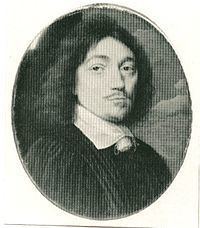Name John Gauden | Died May 23, 1662 | |
 | ||
Education St John's College, Cambridge Books Analysis: The Loosing of Saint Peter's Bands : Setting Forth the True Sense and Solution of the Covenant in Point of Conscience, So Far as it Relates to the Government of the Church by Episcopacy | ||
John Gauden (1605 – 23 May 1662) was an English Bishop of Exeter then Bishop of Worcester and writer, and the reputed author of the important Royalist work Eikon Basilike.
Contents

Life
He was born at Mayland, Essex, where his father was vicar of the parish, and educated at Bury St Edmunds school and at St John's College, Cambridge, where he took his M.A. degree in 1626. He married Elizabeth, daughter of Sir William Russell of Chippenham, Cambridgeshire, and was tutor at Oxford to two of his wife's brothers. He seems to have remained at Oxford until 1630, when he became vicar of Chippenham. His sympathies were at first with the parliamentary party. He was chaplain to Robert Rich, 2nd Earl of Warwick, and preached before the House of Commons in 1640.
In 1641 he was appointed to the rural deanery of Bocking. Apparently his views changed as the revolutionary tendency of the Presbyterian party became more pronounced, for in 1649 he addressed to Lord Fairfax A Religious and Loyal Protestation... against the proceedings of the parliament. Under the Commonwealth he faced both ways, keeping his ecclesiastical preferment, but publishing from time to time pamphlets on behalf of the Church of England. Whilst in Bocking he met William Juniper, the "Gosfield Seer" whom he first dismissed as a harmless fool. However, he was later impressed by prophecies made by Juniper, first that the King would be overthrown, and then that the monarchy would be restored.
At the Restoration he was made bishop of Exeter. He immediately began to complain to Edward Hyde, 1st Earl of Clarendon, of the poverty of the see, and based claims for a better benefice on a certain secret service, which he explained in January 1661 to be the sole invention of the Eikon Basilike, The Pourtraicture of his sacred Majestie in his Solitudes and Sufferings, put forth within a few hours after the execution of Charles I as written by the king himself. To which Clarendon replied that he had been before acquainted with the secret and had often wished he had remained ignorant of it. Gauden was advanced in 1662, not as he had wished to the see of Winchester, but to Worcester. He died the same year.
Authorship question
The evidence in favor of Gauden's authorship rests chiefly on his own assertions and those of his wife (who after his death sent to her son John a narrative of the claim), and on the fact that it was admitted by Clarendon, who should have had means of being acquainted with the truth. Gauden's letters on the subject are printed in the appendix to vol. iii. of the Clarendon Papers.
The argument is that Gauden had prepared the book to inspire sympathy with the king by a representation of his pious and forgiving disposition, and so to rouse public opinion against his execution. In 1693 further correspondence between Gauden, Clarendon, the Duke of York (later James II & VII, and Sir Edward Nicholas was published by Arthur North, who had found them among the papers of his sister-in-law, a daughter-in-law of Bishop Gauden; but doubt has been thrown on the authenticity of these papers. Gauden stated that he had begun the book in 1647 and was entirely responsible for it. But it is contended that the work was in existence at Naseby, and testimony to Charles's authorship is brought forward from various witnesses who had seen Charles himself occupied with it at various times during his imprisonment.
It is stated that the MS. was delivered by one of the king's agents to Edward Symmons, rector of Raine, near Bocking, and that it was in the handwriting of Oudart, Sir Edward Nicholas's secretary. The internal evidence has, as is usual in such cases, been brought forward as a conclusive argument in favor of both contentions.
Doubt was thrown on Charles's authorship in John Milton's Eikonoklastes (1649), which was followed almost immediately by a royalist answer, The Princely Pelican. Royall Resolves Extracted from his Majestys Divine Meditations, with satisfactory reasons that his Sacred Person was the only Author of them (1649). The history of the whole controversy, which has been several times renewed, was dealt with in Christopher Wordsworth's tracts in a most exhaustive way. He eloquently advocated Charles's authorship. Since he wrote in 1829, some further evidence has been forthcoming in favor of the Naseby copy.
A correspondence relating to the French translation of the work has also come to light among the papers of Sir Edward Nicholas. None of the letters show any doubt that King Charles was the author. S. R. Gardiner (Hist. of the Great Civil War, iv, 325) regards Charles Doble's articles as finally disposing of Charles's claim to the authorship, but this is by no means the attitude of other writers.
If Gauden was the author, he may have incorporated papers, &c., by Charles, who may have corrected the work and thus been joint-author. This theory would reconcile the conflicting evidence, that of those who saw Charles writing parts and read the MS. before publication, and the deliberate statements of Gauden.
